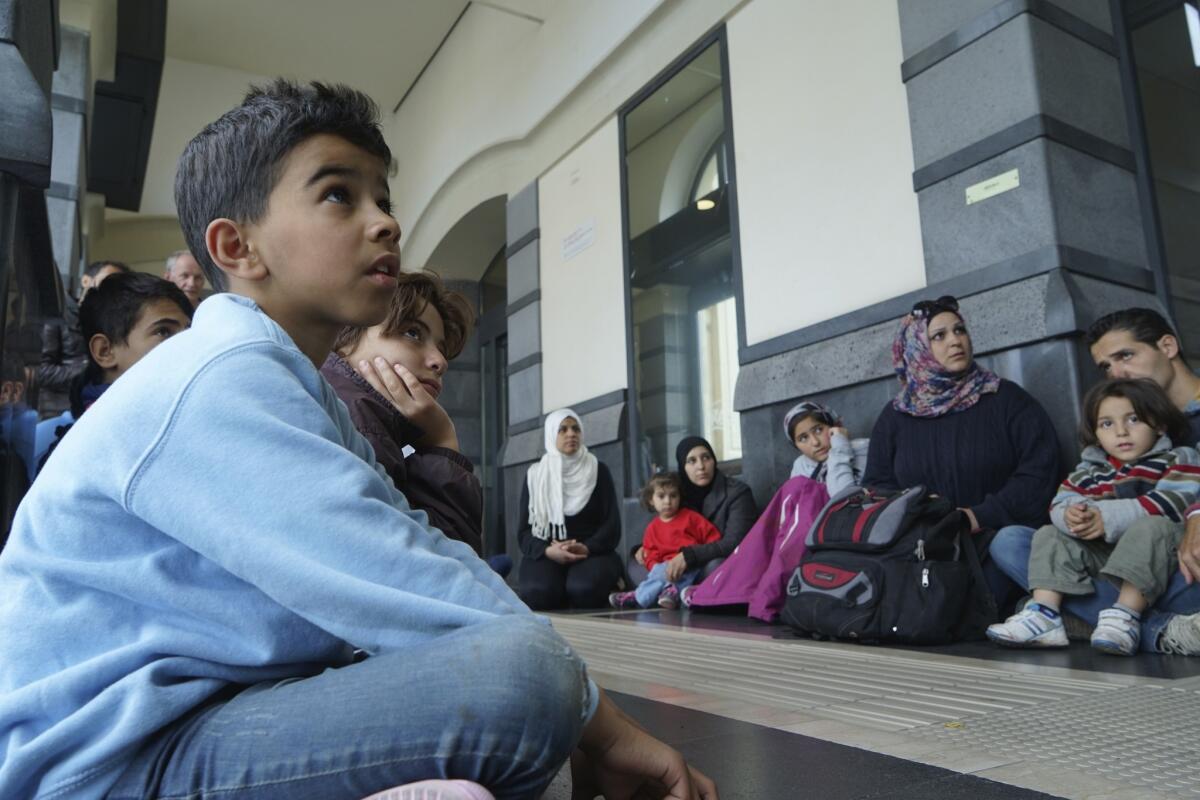Syrian migrants tell of perilous journey to Italy’s coast

- Share via
Reporting from Catania, Italy — The fourth boat used for his family’s journey, packed with about 500 people, mostly Syrians, was the worst, Omar Ibrahim said Thursday at a train station in the shadow of Italy’s snowcapped Mt. Etna.
Ibrahim and about 80 Syrian compatriots were headed for Northern Europe after harrowing odysseys across the Mediterranean Sea from the Middle East.
“It really felt like we could sink anytime in that one,” said Ibrahim, a towering orthodontist from the southern city of Dara who was traveling with his sister, wife and 2-year-old son, Suhaib. “Thank God we made it.”
As European leaders fret about what to do about illicit maritime immigration — even contemplating military strikes against smuggling craft based in North Africa — each day brings new boatloads ashore along Europe’s southern flanks. And the warm-weather season, traditionally the busiest time for the illicit traffic, is only beginning.
On Thursday, European leaders meeting at an emergency summit in Brussels said they would triple the budget for the European Union’s patrol of the Mediterranean to $9.7 million a month. The move followed the capsizing last weekend of a fishing craft packed with migrants that is believed to have left more than 700 drowned, mostly sub-Saharan Africans.
Italy is a major destination, as well as gateway to Europe, both for Africans, the majority of the migrants, and Syrians, who make up a substantial minority. Many migrants crossing the Mediterranean first arrive in Sicily.
For most Africans, the point of embarkation appears to be Libya, relatively close to Italy, whereas many Syrians arrive on vessels from as far away as Turkey or Egypt. The marathon journeys often involve a relay system in which smugglers utilize various craft to move their human cargo across the Mediterranean in calibrated stages.
The traffickers often initially employ fast, small boats to elude Egyptian and other coast guard patrols along the North African coast. The passengers are then offloaded to larger boats for the final stages of the journey. The last boat is usually the least seaworthy, because it is on a one-way voyage and there is little incentive for smugglers to invest in upkeep.
Ibrahim and his family say they took three boats before boarding the final, and most problematic, vessel. The Italian coast guard intercepted the craft after the family had been at sea for a week. Earlier, Ibrahim said, the crew had declined an offer from Greek coastal authorities to help the tottering craft.
“We didn’t want to go to Greece because we knew we would end up sent to a detention center,” Ibrahim said at the crowded train station.
Many Syrians are well coached in how to react to authorities. They prefer to land in Italy, which has a liberal policy toward migrants, in effect letting most pass through on their way to the north. Greece has taken a tougher line.
Although many Africans opt to remain in Italy and proceed with political asylum cases, the Syrians have other destinations in mind: Germany and Sweden, nations with job opportunities and generous social benefits. The Syrians have been instructed to not allow Italian officials to take their fingerprints, which in effect means they can travel on to Northern Europe. Once they are officially identified with fingerprints, they must apply in the country of arrival.
“To Germany!” said one Syrian man, a former resident of Aleppo, as he boarded a train Thursday.
The demographic makeup and ultimate destinations of the Syrians appear distinct from that of the Africans.
Many Syrians arriving in Italy are middle-class professionals who have abandoned relatively comfortable lives because of the turmoil in their homeland. Ibrahim and others said they paid $3,000 per adult to be taken from Egypt to Italian waters. Africans pay $1,000 or so to be transported from Libya.
Italian authorities this week found 90 Syrians packed into a luxury yacht, which had docked in the resort town of Pozzallo on the Sicilian coast. Police said the passengers had paid as much as $8,500 each.
Ibrahim said he and his family were in a hold beneath the deck as the first boat left Egyptian waters. That is considered the most hazardous area because passengers below deck have little chance of surviving a sinking.
At the train station, aid groups distributed toys to children. Migrants went through donated clothes available at the station.
All of the Syrians gathered Thursday at the train station appeared to have begun crossing in Alexandria on the Egyptian coast, before being transported on a series of boats to Italian waters.
Among those waiting for trains were nine members of the extended Adlan family, from Syria’s war-battered Homs province. They were headed for Sweden.
“The last two days were very difficult because we had very large waves,” said Huda Adlan, 18, who waited in the train station with family members.
A kind of underground network helps the Syrians along, guiding them every step of the way.
“They arrive under a lot of stress, not knowing what is going to happen next,” said Nawal Soufi, an Moroccan Italian volunteer who acts like a whirlwind one-woman aid agency, assisting legions of Syrian refugees in Sicily.
Soufi told those at the station what to expect next. Their immediate destination was Milan. There, they would choose whether to travel through France or Austria. Syrian migrants report back to their compatriots about which route is less likely to bring heat from border authorities.
On Thursday, after hours of waiting, many Syrians boarded a train that would take them to a ferry bound for the Italian mainland.
“To Sweden,” a smiling Adlan said as she settled in aboard the train.
Special correspondent Nabih Bulos in Beirut contributed to this report.
More to Read
Sign up for Essential California
The most important California stories and recommendations in your inbox every morning.
You may occasionally receive promotional content from the Los Angeles Times.













